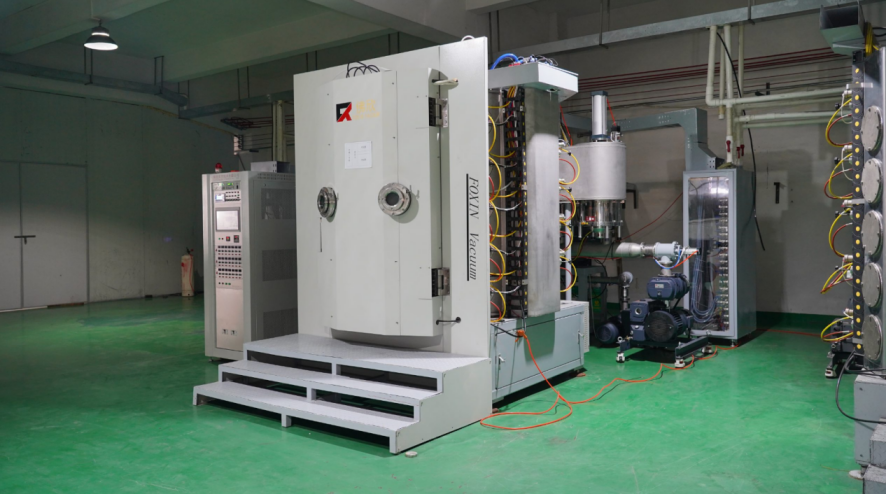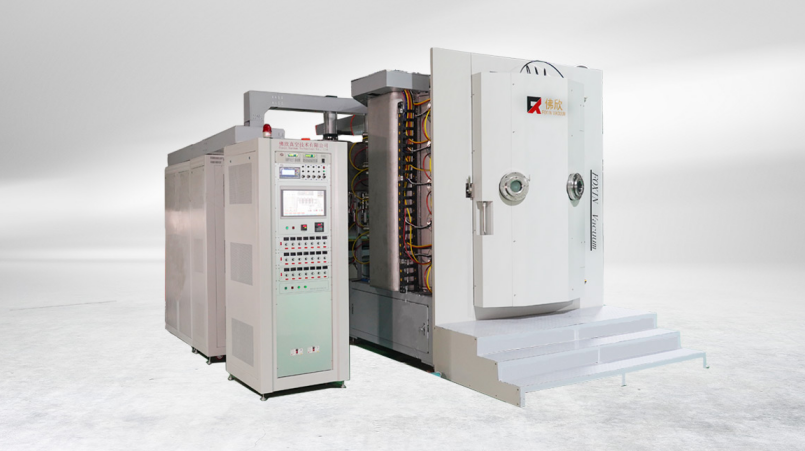
News
12 Year Pvd Coating Machine In Foxin
Exploring the Rapid Growth of the Global Vacuum Coating Equipment Market in 2024
As the spotlight increasingly shifts toward technological progress and environmental sustainability, vacuum coating technology has quietly cemented itself as an indispensable element in modern manufacturing. Ever paused to consider how the sleek surface of your smartphone remains unmarred by scratches, or why those eyeglass frames maintain their flawless metallic luster over time? The secret lies within this advanced coating process, which has not only transformed the way things are made but also reshaped industries such as automotive, electronics, and eyewear.

Looking ahead to 2024, the vacuum coating equipment market is on a swift upward trajectory, fueled by breakthroughs in technology and the rising demand for more sustainable, eco-friendly methods. This piece delves into key trends, notable industry players, challenges, and emerging opportunities, with a special emphasis on Physical Vapor Deposition (PVD) technology. In particular, PVD’s role in eyewear production is profound, providing manufacturers with an elegant solution that balances cost-efficiency, environmental stewardship, and high-quality finishes. It’s a transformative force, redefining both aesthetic and functional aspects of product creation.
Innovations in Vacuum Coating Equipment: What’s Driving the Demand?
Technological Advancements Propelling Market Growth
A primary force behind the rapid rise of demand in the vacuum coating equipment market stems from ongoing technological innovations, which continue to reshape how industries operate. Techniques like Physical Vapor Deposition (PVD) and Chemical Vapor Deposition (CVD) have broadened the application of this technology, making it indispensable in sectors previously less reliant on it. These advancements enable the creation of coatings with enhanced hardness, durability, and aesthetics, which in turn has made them highly sought after in fields such as aerospace, electronics, and optics.
For example, the eyewear industry has greatly benefited from this progress. Manufacturers can now produce frames that not only stand out for their exceptional durability but also captivate with their striking appearance. PVD technology allows a variety of colors and finishes—metallic, matte, or glossy—making it an essential tool for high-end brands aiming to distinguish themselves in an increasingly competitive Vacuum Coating Equipment Market.
Environmental Sustainability as a Major Market Driver
In today’s world, where environmental sustainability sits high on the industrial agenda, the pressure on businesses to adopt greener manufacturing practices is immense. Vacuum coating systems, especially PVD, offer a highly eco-friendly alternative to traditional methods. Unlike older techniques, such as electroplating or painting—which often involve harmful chemicals—PVD produces no toxic by-products or harmful emissions. This makes it an appealing “green” solution, especially for industries seeking to reduce their environmental impact.
In sectors like eyewear, where sustainability is rapidly gaining importance, PVD coatings allow the production of high-quality, long-lasting frames without contributing to environmental harm or waste. This not only addresses ecological concerns but also enhances the Vacuum Coating Equipment Market appeal of products aligned with sustainable practices.

Customization and Premium-Quality Finishes
Customization plays a pivotal role in driving demand for vacuum coating equipment. As consumers increasingly seek personalized products, industries are compelled to deliver tailored solutions that meet specific preferences. Vacuum coating technology allows manufacturers to provide a remarkable degree of precision in finishes, offering an expansive array of colors, textures, and sheens.
Within the eyewear segment, PVD coatings can be adjusted to produce a wide variety of finishes, ranging from luxurious metallic shades like gold and silver to sleek modern hues such as black or copper. This flexibility not only amplifies the visual appeal of frames but also enhances their strength, as PVD coatings are known for their remarkable hardness and superior resistance to wear, ensuring durability and aesthetic longevity.
Challenges and Opportunities in the Vacuum Coating Equipment Market
Overcoming Technological Complexity
Although the advantages of vacuum coating equipment are clear, the adoption of these technologies poses significant hurdles for manufacturers. The machinery involved in processes like PVD and CVD is highly specialized, requiring not only substantial investment in the equipment itself but also in the skilled workforce necessary for operation. For smaller companies, these upfront expenses can be a formidable obstacle, often restricting access to more advanced technologies.
Yet, these challenges bring opportunities as well. Companies like FOXIN, a leader in the Vacuum Coating Equipment Market, have developed innovative strategies aimed at lowering the entry barrier. By offering tailored solutions that cater to specific industrial needs, they help more manufacturers benefit from these advanced systems, enhancing production capabilities without imposing unmanageable financial burdens.
Rising Market Competition and Key Players
As the vacuum coating market continues its upward trajectory, competition among providers is growing more intense. Firms such as FOXIN, Applied Materials, and Bühler Group are investing heavily in research and development to stay ahead of competitors. Their efforts are directed at creating solutions that are not only more efficient but also greener and more cost-effective, aligning with the changing demands of the market.
A case in point is FOXIN’s PVD equipment designed for eyeglass frames, which reduces production cycle times while still maintaining high-quality results. This allows manufacturers to boost output in shorter periods, giving them a crucial edge by cutting costs without sacrificing the excellence of the final product.
The Pursuit of Cost-Effectiveness
One of the biggest challenges in this market lies in finding a balance between cost efficiency and maintaining high product standards. As businesses seek to lower production costs, vacuum coating equipment manufacturers must innovate to provide solutions that are both affordable and effective.
Luckily, technologies like PVD address this challenge well. Not only do they promote environmental sustainability by eliminating harmful chemicals, but they also simplify the production process, which leads to significant cost reductions. This combination makes PVD especially appealing to sectors like eyewear, where keeping production costs in check is essential for profitability.
Top Trends Shaping the Future of the Vacuum Coating Equipment Industry
Strong Growth in Electronics and Automotive Sectors
Demand in the vacuum coating market remains particularly strong in industries like electronics and automotive, where advanced coatings are crucial. These coatings play a significant role in enhancing both the durability and performance of various components. In electronics, they offer protection to delicate internal parts, while in automobiles, they enhance the lifespan and visual appeal of exterior surfaces. The continued need for such applications ensures that these sectors will remain central to the future of this technology.

Increasing Focus on Customization and Personalization
Another growing trend is the increasing desire for customization and personalization, as consumers seek products tailored to their individual preferences. Whether it’s a smartphone case in a specific color or a uniquely finished eyeglass frame, this demand is shaping the market. Vacuum coating technology allows manufacturers to respond effectively by offering an extensive range of customizable finishes and features, helping companies meet the evolving expectations of their customers.
Integration of AI and Automation
As industries across the globe incorporate more automation and artificial intelligence (AI) into their workflows, the evolution of vacuum coating equipment is following suit. The integration of AI within these processes boosts efficiency, minimizes material waste, and ensures consistent quality. This shift is poised to influence the future of the industry, making equipment more precise, adaptable, and reliable across various sectors.
PVD Vacuum Coating Equipment for Glasses Frames: A Case Study
Overview of PVD Technology for Eyewear
PVD vacuum coating equipment is recognized for its ability to apply thin layers of metals or other materials onto eyeglass frames. This technique offers versatility, allowing manufacturers to produce a diverse range of finishes, from metallic to matte and glossy, which makes it ideal for crafting stylish yet durable eyewear.
Advantages of PVD Coatings for Eyeglass Frames
High-Quality Coatings: The coatings generated through PVD are highly uniform, durable, and scratch-resistant, helping frames maintain their appearance even with extended use.
Extensive Range of Finishes: With PVD, manufacturers can create frames in numerous colors and finishes, offering luxurious metallic tones like gold and silver as well as sleek shades like black and blue.
Environmentally Friendly: As a sustainable technology, PVD releases no harmful emissions or by-products, making it an eco-conscious choice for manufacturers focused on reducing environmental impacts.
Main Application in the Eyewear Industry
The primary use of PVD vacuum coating in the eyewear sector lies in the production of high-quality frames with enhanced scratch resistance and durability. This has positioned PVD coatings as the go-to solution for premium eyewear brands, enabling them to deliver products that marry both aesthetics and long-term resilience.
Conclusion
The global vacuum coating equipment market is on a rapid growth trajectory, driven by ongoing technological advancements, an increasing focus on sustainable solutions, and the rising trend of customization. As industry leaders like FOXIN continue to push the boundaries of innovation, sectors such as eyewear manufacturing are poised to benefit from cost-effective, high-quality, and environmentally responsible coating solutions. With trends like AI integration and personalization shaping the future of the market, vacuum coating equipment will remain a vital tool for manufacturers well beyond 2024.
